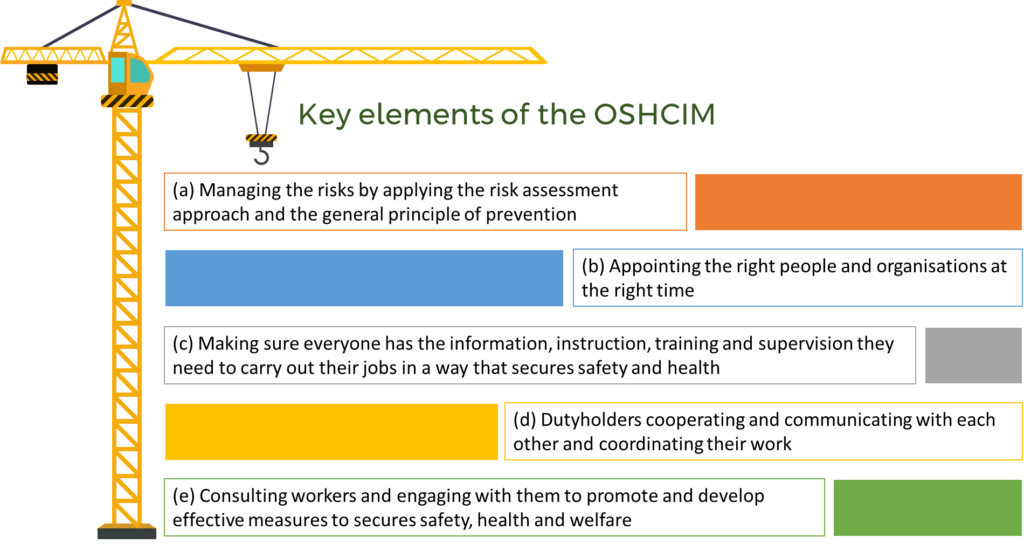Overview of Occupational Safety and Health in Malaysia
The evolution of occupational safety and health (OSH) regulations in Malaysia reflects a growing recognition of the importance of workplace safety. The journey began with establishing specific laws for steam boilers in the late 19th century, leading to comprehensive safety legislation over the decades. Key milestones include the Machinery Ordinance 1953, which marked a significant shift towards broader industrial safety regulations and master plans to enhance OSH standards across various sectors.
Introduction of OSHCIM
The Guidelines on Occupational Safety and Health in the Construction Industry (Management) 2017 (OSHCIM) were developed by the Department of Occupational Safety and Health Malaysia (DOSH) as a proactive measure to improve safety in the construction sector. OSHCIM is based on the Prevention through Design (PtD) concept, which emphasizes integrating safety considerations into the design phase of construction projects. This approach aims to eliminate or reduce hazards before they can affect workers.
The transition from OSHCIM to CDM
OSHCIM is often viewed as a Malaysian adaptation of international frameworks, particularly the Construction Work Design Management (CDM) regulations from the UK and Singapore’s Design for Safety (DFS). CDM and DFS emphasize risk management throughout the project lifecycle, from pre-construction to post-occupational phases. They require various stakeholders, including designers and contractors, to actively participate in identifying and mitigating health and safety risks. The introduction of CDM principles in Malaysia follows the earlier establishment of guidelines such as the Occupational Safety and Health in Construction Industry (Management) 2017 (OSHCIM). OSHCIM laid the groundwork by promoting design-related safety considerations but lacked the enforcement mechanisms that CDM Regulations will introduce. The transition towards CDM is necessary to address increasing accident rates and enhance overall safety standards in construction projects.

CDM Regulations 2024
The Construction (Design and Management) Regulations 2024 (CDM Regulations 2024) significantly advance Malaysia’s construction safety and health management approach. These regulations, which will take effect on June 1, 2024, are designed to enhance the safety culture within the construction industry by clearly defining the responsibilities of all stakeholders involved in construction projects.
Key Features of the CDM Regulations 2024
Duty Holder Responsibilities: The regulations establish comprehensive duties for various parties, including owners, designers, and contractors. Each duty holder is expected to manage safety and health risks throughout all construction project phases, from planning and design to execution and maintenance.
Risk Management Framework: The CDM Regulations emphasize a systematic risk management approach. This includes:
- Avoiding risks where possible.
- Evaluating unavoidable risks.
- Implementing proportionate measures to control risks at their source.
Engagement with Workers: The regulations require principal contractors to engage with workers actively. This includes allowing workers or their representatives to access safety information and participate in safety discussions.
Safety Culture Development: The regulations aim to foster a robust safety culture within organizations by mandating training and awareness programs that align with CDM principles. This is crucial for reducing workplace accidents and fatalities, a growing concern in Malaysia’s construction sector.
Penalties for Non-Compliance: To ensure adherence, the regulations introduce strict penalties for non-compliance, including fines and potential imprisonment for serious violations. For instance, failing to appoint a competent site safety supervisor could result in penalties of up to RM50,000 or imprisonment for up to six months.
Conclusion
Implementing the CDM Regulations 2024 represents a pivotal shift in Malaysia’s construction industry towards a more accountable and safety-focused framework. By embedding these principles into legislation, Malaysia aims to comply with international standards and significantly reduce workplace hazards through proactive risk management and enhanced stakeholder engagement.
